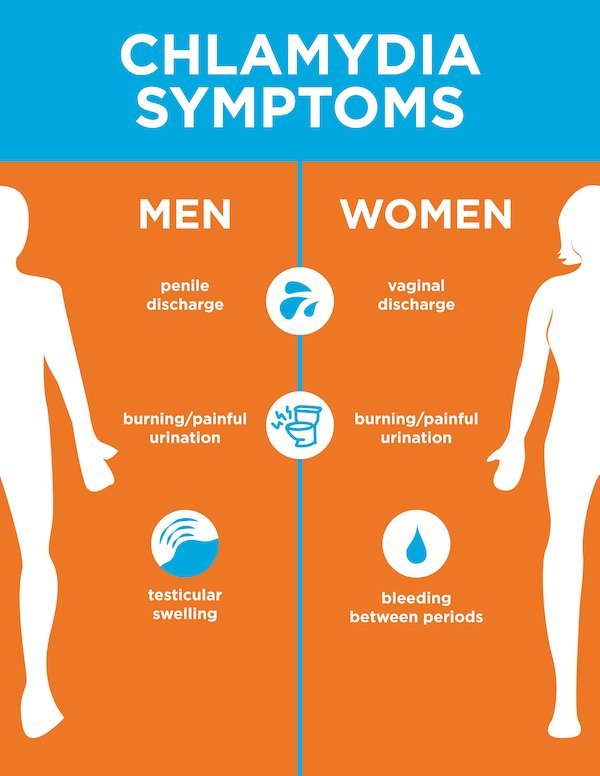Chlamydia Symptoms In Men
If there are signs of Chlamydia in men, symptoms can include:
- Pain or burning sensations when urinating
- Watery, cloudy or white discharge from penis
- Pain in the testicles
Signs of Chlamydia in women can consist of:
- Unusual discharge from the vagina
- Pain when urinating
- Nausea
- Fever
Chlamydia can also affect your rectum or throat as a result of unprotected anal or oral sex. You may experience discomfort or discharge from your rectum, or a sore throat. If you come into contact with infected semen or vaginal fluid in your eyes, this can also result in a Chlamydia infection. If this happens, you might experience from eye redness or conjunctivitis.
What Is The Treatment For Chlamydia
Chlamydia can be easily cured with antibiotics. HIV-positive persons with chlamydia should receive the same treatment as those who are HIV-negative.
Persons with chlamydia should abstain from sexual activity for 7 days after single dose antibiotics or until completion of a 7-day course of antibiotics, to prevent spreading the infection to partners. It is important to take all of the medication prescribed to cure chlamydia. Medication for chlamydia should not be shared with anyone. Although medication will cure the infection, it will not repair any permanent damage done by the disease. If a persons symptoms continue for more than a few days after receiving treatment, he or she should return to a health care provider to be reevaluated.
Repeat infection with chlamydia is common.49 Women whose sex partners have not been appropriately treated are at high risk for re-infection. Having multiple chlamydial infections increases a womans risk of serious reproductive health complications, including pelvic inflammatory disease and ectopic pregnancy.50,51 Women and men with chlamydia should be retested about three months after treatment of an initial infection, regardless of whether they believe that their sex partners were successfully treated.40
Infants infected with chlamydia may develop ophthalmia neonatorum and/or pneumonia.10 Chlamydial infection in infants can be treated with antibiotics.
What Happens If Chlamydia Goes Untreated
If a person is not treated for chlamydia, complications may occur. Women frequently develop pelvic inflammatory disease . PID can cause infertility , chronic pelvic pain, tubal pregnancies, and the continued spread of the disease. In men, untreated chlamydia can cause urethral infection and complications such as swollen and tender testicles. Chlamydia infection during pregnancy may result in premature rupture of membranes, preterm delivery and possible tubal pregnancy in a small percent of women. In addition, chlamydia can cause conjunctival and pneumonic infection in the newborn. Persons with a chlamydia infection have an increased chance of getting other infections such as gonorrhea or HIV.
Also Check: Is Chlamydia And Gonorrhea Curable
What Are The Symptoms Of Chlamydia
Chlamydia is known as a silent infection because most infected people are asymptomatic and lack abnormal physical examination findings. Estimates of the proportion of chlamydia-infected people who develop symptoms vary by setting and study methodology two published studies that incorporated modeling techniques to address limitations of point prevalence surveys estimated that only about 10% of men and 5-30% of women with laboratory-confirmed chlamydial infection develop symptoms.21.22 The incubation period of chlamydia is poorly defined. However, given the relatively slow replication cycle of the organism, symptoms may not appear until several weeks after exposure in those persons who develop symptoms.
In women, the bacteria initially infect the cervix, where the infection may cause signs and symptoms of cervicitis , and sometimes the urethra, which may result in signs and symptoms of urethritis . Infection can spread from the cervix to the upper reproductive tract , causing pelvic inflammatory disease , which may be asymptomatic 23 or acute, with typical symptoms of abdominal and/or pelvic pain, along with signs of cervical motion tenderness, and uterine or adnexal tenderness on examination.
Men who are symptomatic typically have urethritis, with a mucoid or watery urethral discharge and dysuria. A minority of infected men develop epididymitis , presenting with unilateral testicular pain, tenderness, and swelling.24
How Do People Get Chlamydia

Chlamydia is transmitted through sexual contact with the penis, vagina, mouth, or anus of an infected partner. Ejaculation does not have to occur for chlamydia to be transmitted or acquired. Chlamydia can also be spread perinatally from an untreated mother to her baby during childbirth, resulting in ophthalmia neonatorum or pneumonia in some exposed infants. In published prospective studies, chlamydial conjunctivitis has been identified in 18-44% and chlamydial pneumonia in 3-16% of infants born to women with untreated chlamydial cervical infection at the time of delivery.9-12 While rectal or genital chlamydial infection has been shown to persist one year or longer in infants infected at birth,13 the possibility of sexual abuse should be considered in prepubertal children beyond the neonatal period with vaginal, urethral, or rectal chlamydial infection.
People who have had chlamydia and have been treated may get infected again if they have sexual contact with a person infected with chlamydia.14
Recommended Reading: How To Take A Chlamydia Test
What Problems Can Happen
If it’s not treated, chlamydia can lead to:
- in girls: pelvic inflammatory disease , which can damage the reproductive system, making it hard or impossible for a woman to get pregnant later on
- in guys: swelling in the testicles and tubes at the back of the testicles, possibly preventing a man from fathering kids later on
- joint problems
How Long Can You Have Chlamydia Before It Causes Damage
Symptoms usually appear within one to three weeks after being infected and may be very mild. If not treated, chlamydia can lead to damage to the reproductive system. In women, chlamydial infection can spread to the uterus or fallopian tubes and cause pelvic inflammatory disease , according to the CDC.
Also Check: Can I Test Positive For Chlamydia And Not Have It
Complications Of Chlamydia In Males
When left untreated chlamydia can lead to other conditions and symptoms. In men, chlamydia infection can lead to the inflammation of the testicles and the tubes that carry sperm from the testicles . If you develop this complication you may experience:
- Swelling or a lump in the testicle
- Discharge from the penis
- Difficulty urinating or needing to urinate more often
- Later on, problems with fertility
Untreated chlamydia can also cause sexually acquired reactive arthritis , which can lead to:
- Pain, stiffness and swelling in the joints
- Pain and redness in the eyes
- Pain when urinating
Inflammation of the testicles and epididymis can usually be treated with antibiotics. SARA cannot be cured, it normally clears up on its own within a few months, but it is prone to recurrences. SARA occurs 10 times more frequently in men than women.
How Chlamydia Diagnosis Process Is Carried On In Men
Early treatment of Chlamydia is essential to have a healthy life ahead. In case if you had unprotected sex with your recent partner then you must get tested for STIs as soon as possible. This test can be carried out at any local GUM clinic or GP. With improved facilities of digital world, patients can also order Chlamydia test kits to their home from online sources.
Once this test is carried out then depending upon its results further treatment will be carried out. Note that, Chlamydia disease is very common between age groups of 16 to 25 so most of the clinics these days are offering free tests to identify this disease on time. In case if you had oral or anal sex with your new partner who is suspected to be infected then it is good to undergo an oral swab test pr rectal swab test.
You May Like: Is There A Rapid Chlamydia Test
How Does Chlamydia Affect A Pregnant Woman And Her Baby
In pregnant women, untreated chlamydia has been associated with pre-term delivery,34 as well as ophthalmia neonatorum and pneumonia in the newborn. In published prospective studies, chlamydial conjunctivitis has been identified in 18-44% and chlamydial pneumonia in 3-16% of infants born to women with untreated chlamydial cervical infection at the time of delivery.9-12 Neonatal prophylaxis against gonococcal conjunctivitis routinely performed at birth does not effectively prevent chlamydial conjunctivitis.37-39
Screening and treatment of chlamydia in pregnant women is the best method for preventing neonatal chlamydial disease. All pregnant women should be screened for chlamydia at their first prenatal visit. Pregnant women under 25 and those at increased risk for chlamydia should be screened again in their third trimester. Pregnant women with chlamydial infection should be retested 3 weeks and 3 months after completion of recommended therapy.40
Do Men And Women Have Different Chlamydia Symptoms
When infected with chlamydia, men and women may experience different symptoms. Chlamydia is known as one of the most commonly transmitted sexual diseases. The infection can spread rapidly because many people who are infected do not show symptoms for a while, and may unknowingly pass it to partners. Women are less likely to experience symptoms, and 75% of them will have had no symptoms by the time they receive a diagnosis. About 50% of men who are infected will not show symptoms, either.
Don’t Miss: What Medicine Do They Prescribe For Chlamydia
The Health Risks Of Chlamydia
For up to 40 percent of infected women, untreated chlamydia can lead to pelvic inflammatory disease . PID effects include abdominal pain, fever, internal abscesses and long-lasting pelvic pain effects also include scarring of the fallopian tubes, which can cause infertility and increase the chance of potentially life-threatening ectopic or tubal pregnancies.
Men can develop scarring of the urethra, making urination difficult and occasionally causing infertility. Although rare, both sexes are at risk of a type of arthritis known as Reiters Syndrome that causes inflammation and swelling of the joints.
If a pregnant woman has chlamydia, her baby may be born prematurely, have eye infections or develop pneumonia.
Read Also: How Do You Get Chlamydia Female
What Is The Treatment

Chlamydia is treated with antibiotics. It is important to follow the treatment instructions carefully. If you were given pills, finish all of them. Sexual partners from the last 2 months need to be tested and treated. If you have not had a sexual partner in the last 2 months, then your last sexual partner will need to be tested and treated. It takes time for the infection to clear from the body, so it is important that you do not have any oral, vaginal or anal sex for 7 days after you and your partner start the antibiotic treatment.
If you or your partner do not finish the treatment, miss pills or have unprotected sex before you have finished all of the medication, there is a chance that the infection will stay in your body may pass back to you or your partner and cause health problems later. If this happens, talk with your health care provider who will help you to decide if you or your partners need more treatment.
Because re-infection is common, a follow-up test is recommended 6 months after treatment. If you are pregnant or breastfeeding, have a follow-up test 3 to 4 weeks after completing treatment.
Also Check: Instant Chlamydia And Gonorrhea Test
Don’t Miss: How To Treat Chlamydia Naturally
What It Looks Like
Symptoms of oral chlamydia look very similar to tonsillitis or strep throat. The throat will be red, and the tonsils will be swollen. White spots might appear on the back of the throat. In addition, a person might feel swollen lymph nodes on the sides of the neck.
The most accurate way to know whether you have oral chlamydia is through swab testing. Testing for chlamydia outside of the genital area is not a routine part of STD screening, which means that throat infections can go undiagnosed and untreated.
Untreated chlamydia of the throat could be a reason for the ongoing spread of the disease.
Racial Disparity And Chlamydia
The prevalence of chlamydia is drastically different across racial and ethnic groups in the United States. Overall, Black, American Indian and Alaska Native, and Native Hawaiian and other Pacific Islander women have the highest rates of chlamydia, according to the CDC.
In 2017, the reported rate of chlamydia in Black Americans was 5.6 times the rate of white Americans. Among Native Americans and Alaska Natives, this number was 3.7, and for Native Hawaiians and other Pacific Islanders, it was 3.4. Hispanic Americans were 1.9 times as likely to have chlamydia as white Americans, while Asian Americans were only 0.6 times as likely.
Among young women ages 14 to 24, the CDC estimates that the prevalence of chlamydia is about 10 percent for Mexican Americans, and about 8 percent for Black girls and women. This number is only about 2 percent for non-Hispanic white girls and women.
Don’t Miss: If I Have Chlamydia Will I Get Hiv
What Are Symptoms Of Chlamydia In Men
How Common Is Chlamydia
CDC estimates that there were four million chlamydial infections in 2018.3 Chlamydia is also the most frequently reported bacterial sexually transmitted infection in the United States.4 However, a large number of cases are not reported because most people with chlamydia are asymptomatic and do not seek testing. Chlamydia is most common among young people. Two-thirds of new chlamydial infections occur among youth aged 15-24 years.3 It is estimated that 1 in 20 sexually active young women aged 14-24 years has chlamydia.5
Disparities persist among racial and ethnic minority groups. In 2019, reported chlamydia rates for African Americans/Blacks were nearly six times that of Whites.4 Chlamydia is also common among gay, bisexual, and other men who have sex with men . Among MSM screened for rectal chlamydial infection, positivity has ranged from 3.0% to 10.5%.6,7 Among MSM screened for pharyngeal chlamydial infection, positivity has ranged from 0.5% to 2.3%.7.8
Don’t Miss: I Tested Positive For Chlamydia
Effects Of The Disease
Chlamydia can cause infertility if it is not treated. It damages sperm and scars the reproductive tract. It also damages your sperm in ways that can make birth defects prevalent.
Chlamydia can also affect you in non-sexual ways. You can get recurring pink eye, reactive arthritis and rheumatological conditions.
What Other Problems Can Chlamydia Cause
In women, an untreated infection can spread to your uterus and fallopian tubes, causing pelvic inflammatory disease . PID can cause permanent damage to your reproductive system. This can lead to long-term pelvic pain, infertility, and ectopic pregnancy. Women who have had chlamydia infections more than once are at higher risk of serious reproductive health complications.
Men often don’t have health problems from chlamydia. Sometimes it can infect the epididymis . This can cause pain, fever, and, rarely, infertility.
Both men and women can develop reactive arthritis because of a chlamydia infection. Reactive arthritis is a type of arthritis that happens as a “reaction” to an infection in the body.
Babies born to infected mothers can get eye infections and pneumonia from chlamydia. It may also make it more likely for your baby to be born too early.
Untreated chlamydia may also increase your chances of getting or giving HIV/AIDS.
You May Like: Can I Have Chlamydia And Not Know
What Are The Treatments For Chlamydia
If you are diagnosed with chlamydia, your doctor will prescribe oral antibiotics. A single dose of azithromycin or taking doxycycline twice daily for 7 to 14 days are the most common treatments and are the same for those with or without HIV.
With treatment, the infection should clear up in about a week. Do not have sex for at least 7 days until you have taken all of your medication, and do not stop taking the antibiotics even if you feel better.
Your doctor will also recommend that your partner be treated as well to prevent reinfection and further spread of the disease.
Women with serious infections, such as pelvic inflammatory disease, may require a longer course of antibiotics or hospitalization for intravenous antibiotics. Some severe pelvic infections may require surgery in addition to antibiotic therapy.
Make sure you get retested after three months to be certain the infection is gone. Do this even if your partner has been treated and appears to be infection free.
Does Discharge From Your Penis Mean You Have Chlamydia

Not necessarily the presence of a white, cloudy or watery discharge from the end of your penis is a symptom of chlamydia in men. However, discharge can also be a sign of other issues such as:
- a urinary tract infection
- genital herpes
In cases of chlamydia other symptoms which may occur alongside penile discharge include:
- Pain when you pee
- Burning or itching in the tube that carries urine out of your body
- Painful testicles
If you have discharge it may be:
- Watery
- White
- Yellow and pus like
No discharge doesnt mean no chlamydia it’s important to remember that most cases of chlamydia are symptom-free, particularly in men. If you’ve had unprotected sex, i.e. you didnt use a condom, there’s every possibility you could have caught chlamydia. You should get tested even if you have no symptoms, so you can be sure. If chlamydia is left untreated it can cause serious health complications, including some that could affect your fertility.
Recommended Reading: How Can A Man Catch Chlamydia
How Is Chlamydia Spread
You can get chlamydia by having vaginal, anal, or oral sex with someone who has chlamydia.
If your sex partner is male you can still get chlamydia even if he does not ejaculate .
If youve had chlamydia and were treated in the past, you can still get infected again. This can happen if you have unprotected sex with someone who has chlamydia.